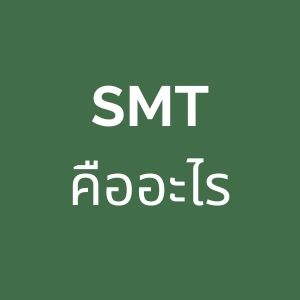เทคโนโลยี Surface-mount (SMT)
เป็นวิธีการผลิตวงจรอิเล็กทรอนิกส์ที่ประกอบหรือติดตั้งโดยตรงบนพื้นผิวของแผงวงจรพิมพ์
(PCB) อุปกรณ์อิเล็กทรอนิกส์ที่ผลิตขึ้นจึงเรียกว่าอุปกรณ์ยึดติดพื้นผิว หรือ ที่เข้าใจกันว่า
surface-mount device (SMD)
ในวงการอุตสาหกรรมนั้นส่วนใหญ่ได้แทนที่วิธีการสร้างเทคโนโลยีผ่านรู หรือ through-hole
technology ของส่วนประกอบที่เหมาะสมด้วยลวดที่นำไปสู่รูในแผงวงจร
เทคโนโลยีทั้งสองสามารถใช้ในบอร์ดเดียวกันได้ โดยใช้วิธีแบบ through-hole technology
ซึ่งสามารถนำมาใช้ สำหรับส่วนประกอบที่ไม่เหมาะสมในการติดตั้งที่พื้นผิว เช่น
หม้อแปลงขนาดใหญ่ และ heat-sinked power semiconductors.
ด้วยการใช้ SMT กระบวนการผลิตจะเร็วขึ้น
แต่ความเสี่ยงของข้อบกพร่องก็จะเพิ่มขึ้นเนื่องจากการย่อขนาดส่วนประกอบ และ
การบรรจุบอร์ดแบบหนาแน่น ในเงื่อนไขเหล่านั้น การตรวจจับ วิเคราะห์ข้อผิดพลาด
จึงกลายเป็นสิ่งสำคัญสำหรับกระบวนการผลิตของ SMT
ส่วนประกอบ SMT มักจะมีขนาดเล็กกว่าชิ้นงานที่ผ่านรู หรือ through-hole
เนื่องจากมีไส้ที่เล็กกว่า หรือไม่มีไส้ที่เลย มันอาจมี Pins หรือ Leads สั้น ๆ มีรูปแบบต่าง ๆ
พื้นผิวสัมผัสแบบแบนเมทริกซ์ของ solder balls (BGAs) หรือ
ปัจจัยลักษณะของตัวส่วนประกอบ
Surface-mount technology (SMT) is a method for producing electronic circuits in which the components are mounted or placed directly onto the surface of printed circuit boards (PCBs). An electronic device so made is called a surface-mount device (SMD). In industry, it has largely replaced the through-hole technology construction method of fitting components with wire leads into holes in the circuit board. Both technologies can be used on the same board, with the through-hole technology used for components not suitable for surface mounting such as large transformers and heat-sinked power semiconductors.
By employing SMT, the production process speeds up, but the risk of defects also increases due to component miniaturization and to the denser packing of boards. In those conditions, detection of failures has become critical for any SMT manufacturing process.
An SMT component is usually smaller than its through-hole counterpart because it has either smaller leads or no leads at all. It may have short pins or leads of various styles, flat contacts, a matrix of solder balls (BGAs), or terminations on the body of the component.
Credit: wikipedia




